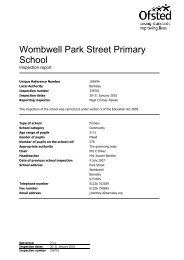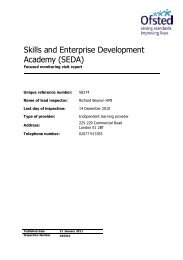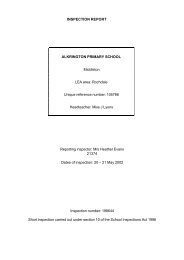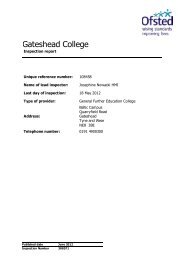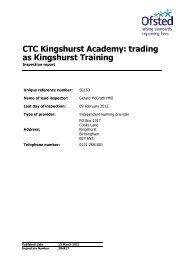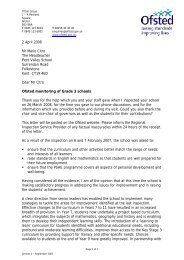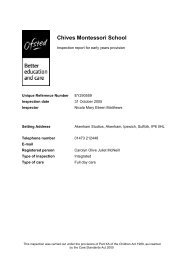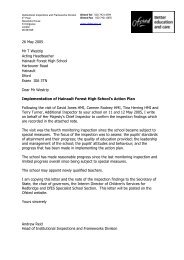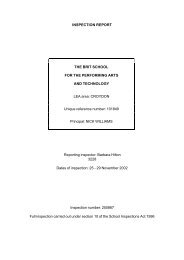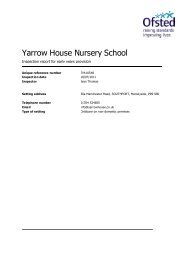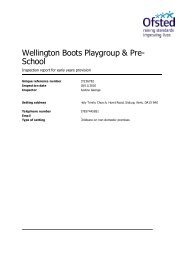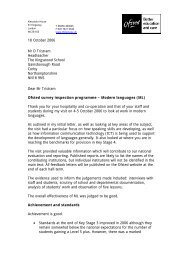pdf School inspection report - Ofsted
pdf School inspection report - Ofsted
pdf School inspection report - Ofsted
Create successful ePaper yourself
Turn your PDF publications into a flip-book with our unique Google optimized e-Paper software.
13. In all other subjects, standards are similar to those expected for pupils’ age except for<br />
art, which is above at both key stages and design and technology and music, which<br />
are slightly below.<br />
Pupils’ attitudes, values and personal development<br />
14. Pupils have very positive attitudes to school. The opinions of the parents that their<br />
children enjoy coming to school are confirmed by the <strong>inspection</strong>. They are keen to<br />
learn, both in lessons and in extra activities at lunchtime or after school. This<br />
eagerness is demonstrated by the way in which they settle quickly to tasks in the<br />
classroom. In a Year 1 class, for example, all pupils were absorbed in their early<br />
morning work in reading and spelling within two minutes of the start of the morning<br />
session. It is also demonstrated by the significant numbers, particularly of older<br />
pupils, who attend after-school clubs for activities such as computers and homework.<br />
In most lessons pupils have a strong desire to do their best. This is evident in the<br />
attractive presentation of their work, although weaknesses in handwriting sometimes<br />
detract from the overall effect. Their capacity to work hard to succeed has a<br />
considerable impact upon the progress they make, particularly in learning to read and<br />
write in English.<br />
15. Pupils work with sustained concentration and often persevere when tasks become<br />
difficult. Very occasionally pupils become inattentive as a result of a lesson which<br />
proceeds at too slow a pace for them, or when they are less interested in the subject<br />
matter. In physical education lessons, a few pupils do not participate fully when the<br />
teacher is not observing them directly.<br />
16. The behaviour of pupils in and around the school is consistently very good and was<br />
similar to the last <strong>inspection</strong>. Parents’ perceptions that the previous high standards<br />
have been maintained are accurate. In classrooms, teachers and support staff have<br />
high expectations of good behaviour and deal with rare infringements with suitable<br />
firmness. Pupils behave sensibly when moving around the school, mostly conforming<br />
well to rules such as keeping left on the stairs. In the playground, aggressive<br />
behaviour is almost entirely absent. Younger pupils sensibly remain within the area<br />
designated for their play. At Key Stage 1, a significant factor in promoting good<br />
behaviour is the presence in the playground of most staff each playtime and their<br />
positive promotion of a range of playground games.<br />
17. On those occasions when larger groups of pupils meet together, behaviour is often<br />
exemplary. For example, in an assembly involving children from nursery age up to<br />
Year 2, all pupils were very interested and attentive as work done by Year 1 pupils<br />
was displayed and carefully explained by the teacher. The absence of disruptive<br />
behaviour enables learning of good quality to occur. There have been no exclusions<br />
from the school.<br />
18. The very good relationships between pupils and adults and between pupils<br />
themselves are a significant strength of the school. Pupils are courteous to visitors<br />
and to each other. All pupils, including those at an early stage of acquiring the<br />
English language, have friendly, yet respectful, relationships with teachers and other<br />
staff members. Adults employed in the school present very positive images of<br />
partnership to the pupils in their charge. For example, when it is necessary, support<br />
staff use their initiative to work flexibly to meet the needs of all pupils. Pupils, in turn,<br />
adopt similar supportive roles. Thus many pupils who have more established skills in<br />
speaking English take the initiative in helping those with lower levels of skills. A Year<br />
1 pupil used her mother tongue to explain the teacher’s instruction when she realised<br />
Greenhill Community <strong>School</strong> - 15



